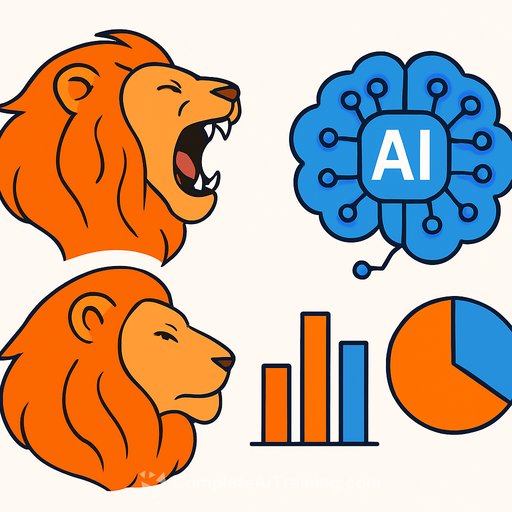AI separates two lion roar types-streamlining acoustic monitoring and conservation
A new study from the University of Exeter shows African lions produce two distinct roars: the classic full-throated roar and a newly identified intermediary roar. Using machine learning, researchers automatically distinguished between them with 95.4% accuracy, removing much of the subjectivity that has held back acoustic monitoring.
For conservation teams under pressure to measure declining populations, this is significant. Reliable, noninvasive tracking gets easier, field decisions get faster, and the data gets cleaner.
Key facts
- Two roar types: Lions produce full-throated roars and a previously unclassified intermediary roar.
- AI precision: Call-type classification reached 95.4% accuracy using simple acoustic features.
- Better IDs: Data-driven selection of full-throated roars improved individual identification (F1-score 0.87 vs. 0.80 for manual).
- Conservation impact: More reliable acoustic monitoring supports stronger population estimates and protection strategies.
What changed
Conventional wisdom held that lions had a single "roar" within a roaring bout. The team demonstrated two: the well-known full-throated roar and a new intermediary roar embedded in the same sequence.
This nuance matters. If you treat all roars as the same, you blur individual signatures and weaken population estimates. Separating the types sharpens the signal.
How the AI worked
Researchers used two approaches. First, two-state Gaussian Hidden Markov Models revealed the presence of two roar types within bouts, classifying them at 84.7% accuracy.
Second, a simpler pipeline using just maximum frequency (Hz) and call duration (s) with K-means clustering reached 95.4% accuracy on call-type classification. That simplicity is good news for teams that need methods they can deploy and maintain in the field.
Critically, when the model's predicted full-throated roars were used, identifying individual lions improved (F1-score 0.87) compared to expert-selected roars (0.80). Less bias, tighter IDs.
Why it matters now
Wild lion numbers in Africa are estimated at 20,000-25,000 and have fallen by about half over the last 25 years. The species is listed as Vulnerable by the IUCN.
Acoustic monitoring is noninvasive, scalable, and increasingly cost-effective compared to camera traps or spoor surveys. With stronger automation and fewer subjective calls, teams can cover larger areas and build more reliable time series for trend analysis.
What field teams can do with this
- Deploy passive acoustic recorders along known territories and movement corridors; prioritize dawn/dusk when roaring peaks.
- Use consistent sampling rates and calibration to keep frequency features comparable across devices and seasons.
- Adopt a simple call-type classifier (frequency + duration) as a first pass, then layer ID models for individual recognition.
- Log environmental metadata (wind, rain, human noise) to flag low-quality segments and reduce false negatives.
- Integrate outputs with camera trap data to validate IDs and refine site-specific priors.
- Standardize file formats and annotation protocols so datasets remain reusable across teams and time.
The broader signal for bioacoustics
This work mirrors advances seen in other large carnivores (e.g., spotted hyaenas) and underscores how call structure carries individual signatures. As acoustic grids expand and models stabilize, we'll move closer to reliable density estimates from sound alone.
The study appears in Ecology and Evolution and was conducted by researchers at the University of Exeter with collaborators from the Wildlife Conservation Unit (University of Oxford), Lion Landscapes, Frankfurt Zoological Society, TAWIRI, TANAPA, and computer scientists from Exeter and Oxford.
Ecology and Evolution (journal)
Quotes worth noting
"Lion roars are not just iconic - they are unique signatures that can be used to estimate population sizes and monitor individual animals," said lead author Jonathan Growcott. "Our new approach using AI promises more accurate and less subjective monitoring, which is crucial for conservationists working to protect dwindling lion populations."
Funding and support
The work was supported by the Lion Recovery Fund, WWF Germany, the Darwin Initiative, and the UKRI AI Centre for Doctoral Training in Environmental Intelligence.
If you work in science and research
The takeaway is simple: keep your acoustic features minimal, your models transparent, and your pipelines reproducible. That makes deployment and cross-site comparisons far easier.
If you're building your AI skillset for ecological monitoring or data analysis, you might find these resources useful: AI courses by job.
Your membership also unlocks:





